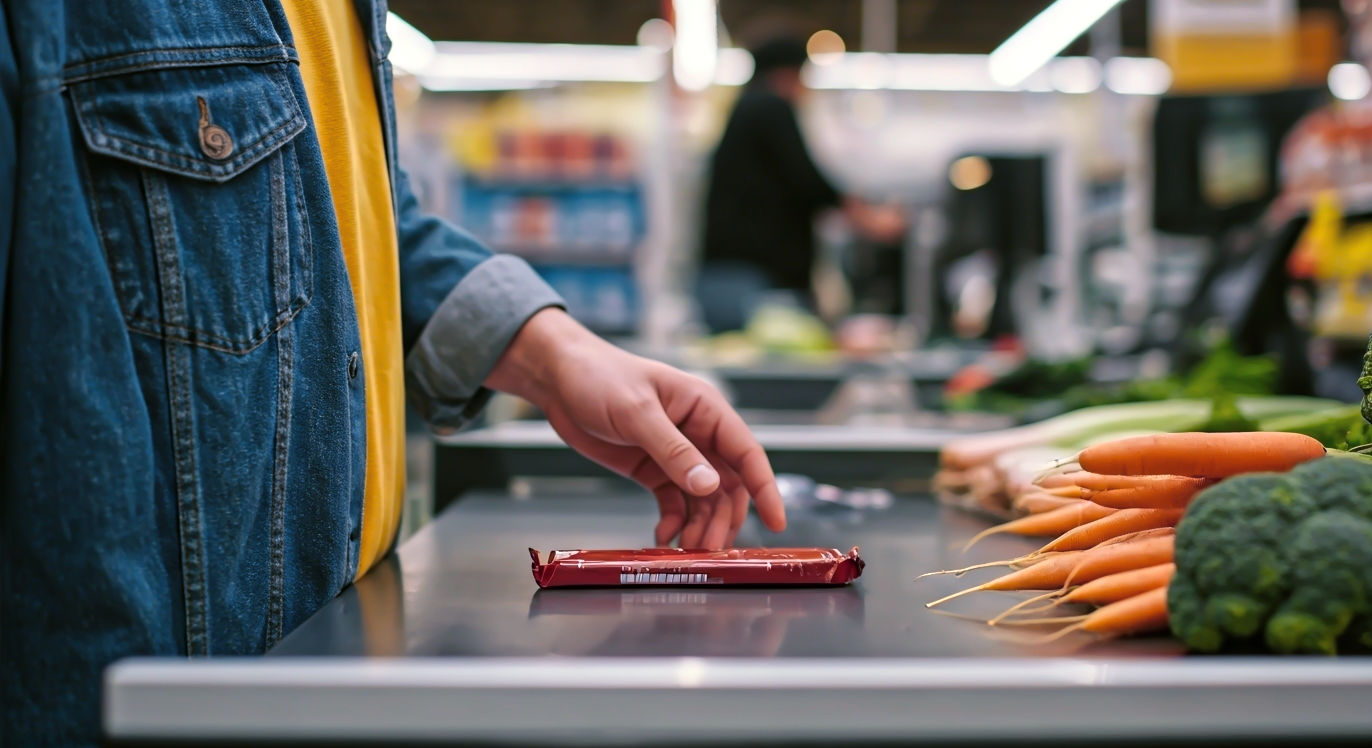The Great British Checkout: How to Find Your Zen in the Final Five Minutes of Shopping
Transform the dreaded checkout queue into a moment of calm. Learn how to use simple mindfulness techniques to avoid impulse buys and feel more in control.

This post may contain affiliate links. If you make a purchase through these links, we may earn a commission at no additional cost to you.
Picture this. You’ve done the big shop. Your trolley is groaning under the weight of a week’s worth of grub, you’ve navigated the cereal aisle without causing a pile-up, and you’ve even remembered the fabric softener. Victory is in sight. All that stands between you and a well-deserved cup of tea is the checkout.
But this isn’t just a queue. It’s a carefully crafted psychological battleground. The sweets are winking at the kids (and, let’s be honest, at you). The magazines are whispering gossip. The last-minute ‘bargains’ are screaming for your attention. Before you know it, three chocolate bars, a copy of Hello!, and a newfangled vegetable peeler have mysteriously jumped into your trolley. You’ve just been played by the checkout.
For decades, this final stretch of our shopping trip has been designed to make us spend more, not think more. It preys on our tiredness, our boredom, and our desire for a little treat. But what if we could turn this moment of mindless consumption into a moment of mindfulness? What if, instead of being a place of stress and temptation, the checkout became a mini-retreat? A chance to pause, breathe, and reconnect with ourselves before heading back into the hustle and bustle of life.
This guide is your secret weapon. We’re going to explore creative, simple, and downright genius ways to transform the checkout experience. From the psychology behind those tempting displays to practical tips you can use in your local Tesco, Sainsbury’s, or corner shop, we’ll show you how to be more mindful, save a bit of cash, and leave the shop feeling calmer and more in control. It’s time to reclaim the checkout.
What is Mindfulness, Anyway? And Why Bother at the Checkout?
Before we dive in, let’s get one thing straight. Mindfulness isn’t about emptying your mind or chanting ‘om’ while the person behind you sighs impatiently. It’s much simpler than that.
Mindfulness is simply paying attention to the present moment, on purpose, without judging it.
Think about it. How often are you truly present in the checkout queue? Usually, your mind is racing. You might be mentally ticking off your to-do list, worrying about the traffic on the way home, or scrolling through your phone to escape the boredom. You’re anywhere but here.
This is what we call ‘autopilot’. Your body is in the queue, but your brain is checked out. And that’s when the sneaky checkout psychology works its magic. When we’re not paying attention, it’s easy to fall back on old habits and make impulse decisions we later regret. A mindful approach flips the script.
The Brain on Autopilot vs. The Mindful Brain
Let’s break it down with a simple analogy.
- Your Autopilot Brain: Imagine this is a busy London Underground train at rush hour. It’s loud, chaotic, and everyone is just trying to get to their destination as quickly as possible. You’re being jostled around, reacting to things without thinking. A packet of wine gums catches your eye – you grab it. The train (your habit) carries you along without you even realising what you’re doing.
- Your Mindful Brain: Now, imagine you’re sitting in a quiet carriage on the Flying Scotsman, gliding through the beautiful Yorkshire Dales. You can see the landscape clearly, notice the details, and feel the gentle rhythm of the train. You have space to think. You see the wine gums, you notice the urge to buy them, but you can also pause and ask yourself, “Do I really want these? How will I feel after I eat them?” You are in control, not the train.
Bringing this mindful awareness to the checkout has some brilliant benefits:
- It Saves You Money: This is the big one. When you’re paying attention, you’re far less likely to buy things you don’t need. Over a year, saving a few quid on each shop really adds up.
- It Reduces Stress: Queues are stressful. Mindfulness techniques, like focusing on your breath, can calm your nervous system and make the wait feel less frustrating.
- It Promotes Healthier Choices: Most impulse buys at the checkout aren’t exactly superfoods. Being mindful gives you that crucial pause to choose a healthier option, or nothing at all.
- It Gives You Back Control: You become an active participant in your shopping trip, not just a passive consumer being led by clever marketing. It feels good to make conscious choices.
So, how did the checkout become such a minefield in the first place? To win the battle, we first need to understand the enemy’s tactics.
A Brief History of Checkout Temptation: How They Got Us Hooked
The checkout wasn’t always a treasure trove of treats. In the early days of self-service shops, which really took off in the UK after the Second World War, the checkout was just that – a place to check out your items and pay. It was functional, not psychological.
But as retailers got smarter, they realised this “dead time” in the queue was a golden opportunity. American supermarket pioneers in the 1950s and 60s started experimenting. They placed magazines, sweets, and other small, cheap items right by the till. They called these “impulse buys” – things people would purchase on a whim.
The Science of the “Impulse Buy”
Retailers tapped into some basic human psychology:
- Decision Fatigue: After making hundreds of small decisions throughout the shop (“Which brand of beans? Ripe bananas or slightly green?”), our willpower is drained. By the time we reach the checkout, we’re tired and more likely to give in to temptation. It’s the brain’s way of saying, “I can’t make another sensible decision, just give me the chocolate!”
- The “Treat” Mentality: We feel we’ve earned a reward for completing the chore of shopping. The checkout provides an easy, instant treat.
- Pester Power: This is a tactic as old as time. Retailers know that placing sweets and toys at a child’s eye level will lead to nagging. Many parents buy the item just for a bit of peace and quiet. In fact, this became such a problem that in 2013, supermarkets like Lidl and Tesco started trials for “guilt-free” or “healthy” checkouts after pressure from parents and health campaigners.
These tactics spread across the pond and were perfected by British supermarkets. The layout of the checkout area, known in the industry as the “point of sale” (POS), is now a multi-million-pound science. Every single item is placed for maximum impact.
Today, this has evolved. Online shopping has created a digital checkout aisle, with “You might also like…” suggestions and last-minute offers popping up just before you click “pay”. The battleground has simply changed location. Understanding this history is crucial – it shows us that our impulse buys aren’t a sign of personal weakness. We are all susceptible to a system that has been refined over 70 years to make us spend.
Your Mindful Checkout Toolkit: 7 Creative Ways to Stay Present
Right, we’ve understood the why and the how. Now for the fun part: the what. Here are seven creative and practical strategies to transform your checkout experience. You don’t have to do them all at once. Try one or two on your next shop and see how they feel.
1. The “Single-Tasking” Challenge
Our phones are our favourite way to escape boredom. But they are also the biggest enemy of mindfulness. The next time you’re in the queue, try this simple challenge: don’t look at your phone.
Instead of scrolling, use your senses to anchor yourself in the present moment. This is a classic mindfulness technique called grounding.
- What do you see? Look at the colours and shapes around you. Notice the design on the chewing gum packet, the headline on the newspaper, the expression on the cashier’s face. Don’t judge it, just observe.
- What do you hear? Listen to the beep of the scanner, the rumble of the conveyor belt, the chatter of people around you. Can you pick out the furthest sound? The closest?
- What do you feel? Feel your feet flat on the floor. Notice the weight of the shopping basket in your hand, or the texture of your coat sleeve.
This might feel a bit strange at first, but it pulls your brain out of its frantic, distracted state and into the here and now. You’re not trying to stop thinking; you’re just giving your attention a new job to do.
2. The “Trolley Audit” Game
This is a brilliant one for saving money and reducing waste. While you’re waiting, use the time to become a detective and audit your own trolley.
The game is simple: find one thing you can put back.
Look through your items. Ask yourself a few questions about each one:
- “Did I come here specifically to buy this?”
- “Do I have something similar at home already?”
- “How will I feel about this purchase tomorrow?”
- “Is this a ‘want’ or a ‘need’?”
This isn’t about depriving yourself. It’s about making a conscious choice. You might look at a fancy jar of pesto and realise you’ve still got half a jar in the fridge. You might spot the biscuits that sneaked in and decide you’d rather save the calories and the cash.
It turns the boring wait into a proactive, empowering activity. And if you have kids with you, get them involved! Turn it into a treasure hunt: “Can you find the one thing in our trolley we don’t really need?”
3. The “Gratitude” Practice
Waiting in a queue can feel like a waste of time, which makes us irritable. We can flip this feeling by using the time for a quick gratitude practice. It sounds a bit fluffy, but the science is solid: practising gratitude can genuinely make you feel happier and less stressed.
You don’t need to do anything dramatic. Just quietly, in your head, think of three things you’re grateful for.
They don’t have to be big things. It could be:
- “I’m grateful for this food that will nourish my family.”
- “I’m grateful I have the money to pay for these groceries.”
- “I’m grateful for the friendly person who let me go ahead of them in the aisle.”
This simple act shifts your brain’s focus from what’s annoying (the wait) to what’s good in your life. It replaces frustration with a sense of calm and appreciation. It’s like a mini-reset for your mood.
4. The “Breathe the Queue Away” Technique
This is mindfulness at its most basic and most powerful. When you feel the familiar frustration of the queue building up, turn your attention to your breath.
The technique is called box breathing, and it’s so effective that even the SAS use it to stay calm under pressure. If it works for them, it can definitely work in the queue at Asda.
Here’s how you do it:
- Breathe in slowly through your nose for a count of four.
- Hold your breath for a count of four.
- Breathe out slowly through your mouth for a count of four.
- Hold your breath for a count of four.
- Repeat.
Do this for a minute or two. It works because it forces you to slow down your breathing, which sends a signal to your brain that everything is okay. It calms your fight-or-flight response. No one around you will even know you’re doing it. It’s your own little pocket of calm.
5. The “Human Connection” Experiment
In our rush, we often treat the cashier as part of the machine – a scanner of items and a taker of money. But they are a human being, often standing on their feet for hours dealing with grumpy, stressed-out people.
The experiment is this: make a genuine, human connection with the cashier.
This doesn’t mean telling them your life story. It can be as simple as:
- Making eye contact.
- Giving them a real smile.
- Saying “Hello, how’s your day going?” and actually listening to the answer.
- Saying “Thank you” and using their name if they have a name badge.
This small act of connection does two things. Firstly, it pulls you into the present moment and out of your own head. Secondly, it’s a small act of kindness. It can brighten their day and, in turn, make you feel good too. It transforms a transaction into an interaction.
6. The “Sensory Unpacking” on the Conveyor Belt
This is a lovely, tactile way to practise mindfulness. As you unload your items onto the conveyor belt, don’t just dump them on. Handle each one with attention.
Pay attention to the physical sensations of each item.
- Feel the cold, smooth skin of an apple.
- Notice the crinkle of the pasta packet.
- Feel the weight and solidity of a tin of beans.
- Observe the vibrant colours of the vegetables.
Think of it as the opposite of the frantic rush we’re usually in. You’re taking a moment to appreciate the food you’re about to buy. This simple act of paying attention can make you feel more connected to your food and more appreciative of it. It’s a moment of calm in the chaos.
7. The “Digital Checkout Declutter”
Mindfulness isn’t just for physical shops. The online checkout is arguably an even bigger minefield of temptation and distraction. Here’s how to apply these principles online.
Before you click “Proceed to Checkout”, take a digital pause.
- Review Your Basket Mindfully: Go through the “Trolley Audit” game. Is there anything in your virtual basket you clicked on impulsively? Do you really need it?
- Step Away From the Screen: Before you enter your payment details, close the laptop or put your phone down for five minutes. Go and make a cup of tea. This creates a “cooling off” period and breaks the spell of the “must-buy-now” urgency that online retailers create.
- Unsubscribe as You Go: See that annoying pop-up asking for your email? Instead of just closing it, take 30 seconds to find the unsubscribe link in the last email they sent you. This is a gift to your future self, creating a calmer, less cluttered inbox.
- Use Shopping Lists: Never browse an online store without a clear list. It’s the digital equivalent of going to the supermarket when you’re hungry – a recipe for disaster.
By applying these mindful checks, you can navigate the world of online shopping with the same conscious control as you would in a physical store.
Building a Mindful Habit: Making It Stick
These techniques are powerful, but they only work if you remember to use them. The key is to turn them into a habit.
The best way to do this is to use a trigger. A trigger is a cue that reminds you to do your new habit. In this case, the trigger is obvious: joining the checkout queue.
Tell yourself: “Okay, every time I get into a queue, I will practise one of my mindful techniques.”
You could even put a small sticker on your wallet or phone case as a visual reminder. Or set a recurring reminder on your phone for your usual shopping time.
Start small. Maybe for the first week, your only goal is to not look at your phone in the queue. The next week, you could add in the “Trolley Audit”. Over time, these small actions will build into a strong, automatic habit. You’ll find yourself doing them without even thinking about it.
The Future of the Checkout: Will Technology Help or Hinder?
The checkout is changing fast. We’re seeing more self-service tills, “scan as you shop” technology, and even till-free stores like Amazon Fresh, where you just walk out with your items.
Will this make mindfulness easier or harder? It’s a bit of both.
- The Potential Pitfalls: Technology can make shopping so seamless and frictionless that we think even less about our purchases. When you don’t have the “pain” of physically handing over money or even scanning your items, it can feel less real, making it easier to overspend.
- The Potential Positives: On the other hand, removing the queue removes a major stressor. “Scan as you shop” apps allow you to see a running total, which can make you more mindful of your budget. Perhaps the future checkout will be less of a physical space and more of a mental one – a final confirmation screen on an app that gives us a perfect moment to pause and reflect before we commit.
Ultimately, technology is just a tool. It’s how we use it that matters. The principles of mindful consumption – pausing, questioning our impulses, and making conscious choices – will be just as important in a world of automated, checkout-free stores as they are in the familiar queues of today.
The checkout doesn’t have to be a place of stress, temptation, and mindless spending. It can be a powerful opportunity, a few minutes carved out of a busy day, to practise a skill that can benefit every area of our lives. It’s a training ground for staying calm under pressure, for making conscious choices, and for finding a little bit of peace in the middle of the mundane.
So, the next time you’re standing there, with your trolley full and your patience wearing thin, remember you have a choice. You can let autopilot take over, or you can take a breath, look around, and choose to be present. You can choose to check in with yourself, long before you check out.
Further Reading
For those interested in delving deeper into mindfulness, consumer psychology, and conscious spending, here are some highly respected resources:
- The NHS: The official NHS website provides excellent, practical, and evidence-based guidance on mindfulness for mental wellbeing.
- Mindful.org: A leading non-profit organisation dedicated to sharing the benefits of mindfulness. They offer guided practices, articles, and courses.
- MoneySavingExpert: Founded by Martin Lewis, this website is the UK’s go-to resource for saving money and making smarter consumer choices. It often touches on the psychology of spending.
- Nudge: Improving Decisions About Health, Wealth, and Happiness by Richard H. Thaler and Cass R. Sunstein: This book is a fascinating introduction to “nudge theory” and the subtle forces that shape our decisions, including our shopping habits.
- The British Psychological Society (BPS): The BPS often publishes articles and research on consumer behaviour and the psychology of decision-making, offering a scientific perspective on the topics discussed.






